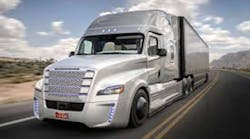Why Lean Thinking and Shop Problem-Solving are Critical for Truck Equipment Distributors
Jon Sievert says he gets many different answers when he asks people to describe lean: tightening the belt; doing more with less; reducing inventory; cost-savings program; waste elimination; quality program; reducing head count; and turnaround tool.
“When you look at this word, it has come to mean many different things to people, and it also means not much to anyone,” said Sievert, senior VP of operations for Henderson Products. “Most people think of it as a manufacturing-focused set of tools. In actuality, lean is about problem-solving. Everything with lean is problem-solving. Those tools were all created to solve some sort of problem that someone has at some point along the way.”
In his presentation, “Why Lean Thinking and Shop Problem-Solving are Critical for Truck Equipment Distributors,” he said problem is often viewed as a dirty word.
“The true definition of a problem is knowing where you want to be and know where we are today. The difference between those two is a gap. Any time you have a gap, you have a problem. So typically problems are reactive. We want to be here, and our quality or our delivery, or whatever it is, is down here. You have this gap.”
He gave an example of a company that has a lead time of 120 days. Here are some things that go into it: sales and marketing activity; take the order; writing order, design and ordering material; fabricate the job; wait for paint; paint the job; receive accessories; final assembly; customer sign; deliver the job; fix any defects or make repairs; invoice; chase payments; and get paid.
The value items are: taking the order; fabricating the job; painting and final assembly; delivering the job; invoicing; and getting paid.
“Value is anything the customer is willing to pay for and also anything that positively affects the customer’s present situation,” he said. “Are you willing to pay for something that has a negative effect on your life? Do we find value in that? No, we don’t.”
Sievert said every single person in the audience has the same person working in their organization. His name is T.I.M. I. W.O.O.D.
“He’s just a normal-looking guy, but he’s in every single organization in the entire world,” he said. “T.I.M. is actually wanted in every one of our organization for distributing waste. We actually want to fire T.I.M.”
T.I.M. is actually an acronym for the eight deadly wastes:
• Transportation.
“Any excess or unnecessary movement of materials or information. Examples: chasing parts; walking to the parts room; moving vehicles in and out of bays; picking up a body and moving it slowly through factory. We can never fully eliminate transportation. But that person who’s transporting things could be adding value to the process. To figure out how much transportation waste you have, go to Wal-Mart and buy a $10 pedometer, put it on your employees, and every night break down how many miles they walk. We did this in our facility in Iowa. We had the actual shop techs wearing them. One individual walked 15 miles in one day. And he’s one of our most trusted employees.”
• Inventory.
“It can be in the form of piles of files, information, raw materials, work in process, and finished goods. It can be all the parts we have. It can be people. Inventory is an asset we need in order to run the business, but we often get too much of that asset. Inventory is like a big, cozy blanket. When we see the chassis lined up with daisies popping up in the fields, we feel nice and cozy. ‘Man, look at that backlog. Look at all that great work we’ve got to do.’ But who’s waiting on all that waste? The customer. Inventory makes us feel comfortable, but it’s a very expensive way to feel comfortable. Why is it waste? It ties up cash and space. It covers up problems.”
• Motion.
“Any movement or motion that does not add value. This one is tougher to see in most cases. It’s doing things I don’t necessarily need to do. I think about the surgeon. Does he get his own gauze pads? He puts his hand out and someone sticks it in his hand. If we need information, we have someone go find a computer and look it up. Every time we do that, we have motion waste. And we’re not adding value to the product.”
• Information wastes.
“It’s information that is unclear, incomplete, redundant, unavailable, unnecessary, or missing. We use lots of words. We have a document of specs that’s full of words. When someone wrote those words, they had a picture in their head of what those words would mean. Someone started grabbing it and reading them and building a picture in their head through words. But is the picture in my head the same as the person who wrote it? More than likely not. Information can actually get in our way, especially when it’s unclear or missing.”
• Waiting.
“One of the most frustrating forms of waste for employees is waiting. That involves waiting for: the copier; the scanner; a document to be retrieved; a reply to emails; information; the right tool; and equipment to become available. Look around, how many people at any one time are waiting for something? What are we not doing? Working. We take our minds off what we were working on and lose focus. Then we have to jump back to it. Every time you open up another thing to work on, the amount of work you have to manage every day continues to grow—all because I had to wait. Waiting becomes frustrating. Most employees get paid to do what they do, so nobody wants to stand around and wait.”
• Over-processing.
“Doing more than the customer wants, needs, or is willing to pay for. This one becomes part of waiting. Because we’re waiting, we over-process and open up another job. You’ve got all these half-built tasks sitting in the yard. ‘Oh. Bill’s on vacation, he started that job.’ Lots of times when we’re waiting, we want to add more value to the process. So we slow down what we do, we take a little more time to straighten up and to shrink-wrap everything real nice to make it look good for the customer. Typically, it’s because we have the time to do it—maybe more than the customer is willing to pay for. You’ve got to get back to that definition of value.”
• Over-production.
“Doing more than is necessary to meet customer demand. This can also be described as ‘make work.’ The industry is taking off right now and people are finding a boom in what’s going on around them. In order to get more done, we feel like we need to put more into the system. You end up putting significantly more in than what comes out. We put more work in. ‘Let’s see if we can find another spot to put in another chassis.’ We keep jamming more in and no one can figure out why we aren’t getting more out at the other end. It’s because we didn’t put the processes in place. We didn’t actually solve any problems that we needed to. We just shoved more into the system. Now we’ve got more costs and people and time tied up all because we wanted to get more out of the system.”
• Defects.
“Any mistakes or errors in the business. Defects are around us every day. When a defect happens, what’s the first question we ask? ‘Who did that?’ As soon as we ask the who question, boom, we just shoved everybody down. Who’s going to want to stand up and say, ‘Oh, I did that’? The challenge with defects is not to run people over when you find the defects. Ask, ‘What happened? How did that happen? What are we going to do to fix it?’ ”
He said a company has variability in its system—“strategic/competitive variability”—that helps it to continue to grow the business.
“Being able to do what the customer is looking for—this kind of variability is what we want,” he said. “We want to be able to create product lines that fit together, to have innovative solutions for the customer. We have to take that picture the customer has in his head and build it for him. The #1 question I get when it comes to lean and upfitting facilities or distribution centers is, ‘What about the customer piece? How do I deal with that?’ The first question I ask is, ‘OK, Customer A wants to build it this way and Customer B wants it this way. These are two things that are very different.’
“If you break it down to simple elements, what we do every day is consistent: hydraulics, turning wrenches, running torches. So what we want to try to do with variability is to actually increase strategic variability and decrease dysfunctional variability. Dysfunctional variability is waste. If we have all that waste in our systems, how can we increase that strategic variability?”






